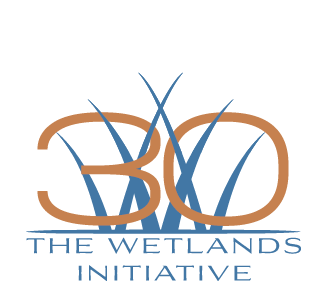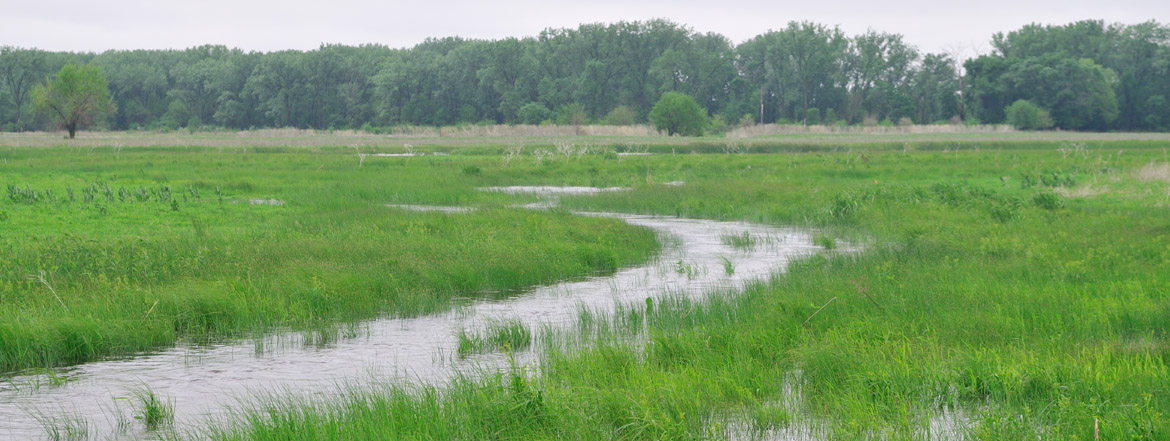What is a Wetland?
Simply stated, wetlands are parts of our landscape that are defined by the presence of water. More specifically, wetlands are areas where the presence of water determines or influences most, if not all, of an area's biogeochemistry—that is, the biological, physical, and chemical characteristics of a particular site.
Many wetlands are transitional zones between upland and aquatic ecosystems, although others are scattered across the landscape in upland depressions that collect water or in zones where groundwater comes to the surface.
The amount of water present in a wetland can vary greatly. Some wetlands are permanently flooded, while others are only seasonally flooded but retain saturated soils throughout much of the unflooded period. Still other wetlands may rarely flood, but saturated soil conditions still are present long enough to support wetland-adapted plants and for hydric soil characteristics to develop. Hydric soils develop when chemical changes take place in the soil due to the low-oxygen conditions associated with prolonged saturation.
Different plant communities may be found in different types of wetlands, with each species adapted to the local hydrology (the quantity, distribution, and movement of water throughout a given area). Wetland plants are often referred to as hydrophytes because they are specially adapted to grow in saturated soils. Many bird, insect, and other wildlife species are completely dependent on wetlands for critical stages in their life cycles, while many other species make use of wetlands for feeding, resting, or other life activities.
Defining Wetlands
Although we can readily describe wetland characteristics and what they do, there has been a lot of discussion over how to specifically define what constitutes a wetland. A workable definition became critical in classifying habitat for legal purposes, especially in determining which lands are protected by state and federal legislation. The U.S. Fish and Wildlife Service defined wetlands as follows in 1979:
Wetlands are lands transitional between terrestrial and aquatic systems where the water table is usually at or near the surface, or the land is covered by shallow water. . . . Wetlands must have one or more of the following three attributes: 1) at least periodically, the land supports predominantly hydrophytes; 2) the substrate is predominantly undrained hydric soil; and 3) the substrate is saturated with water or covered by shallow water at some time during the growing season of each year.
Types of Wetlands
There are many different types of wetlands, each determined by its hydrology, water chemistry, soils, and the plant species found there. Wetlands may be characterized as dominated by trees, shrubs, or herbaceous vegetation. They may be fed by precipitation, runoff, or groundwater, with water chemistry ranging from very acidic to alkaline. Below are some of the major wetland types found in the Upper Midwest.
Marshes are wetlands that are permanently flooded or flooded during high water periods at the edges of rivers, streams, lakes, or ponds. Marshes may be dominated by submersed, floating-leaved, or emergent vegetation, including cattails, pondweeds, water lilies, and various sedges, rushes, spike rushes, grasses, and forbs (broad-leaved flowering plants). Marshes can be subcategorized into emergent marsh and hemi-marsh.
Developing emergent marsh at Midewin National Tallgrass Prairie.
Emergent marsh is the marsh found around shorelines out to relatively shallow water, and is generally characterized by up to 100% cover with emergent plant species. In the Midwest, these species may include graminoids (grasses and grass-like plants) such as river bulrush and rice cut grass, as well as characteristic forbs such as purple false foxglove, nodding bur marigold, pickerel-weed, and duck potato. These marshes are ideal habitat for a wide range of animals, including mink, muskrat, raccoons, Great Blue Herons, and a multitude of dragonflies, butterflies, and other insects. Emergent marshes also provide critical habitat for rare amphibians and reptiles such as the plains leopard frog and Blanding's turtle. In the extensive marsh habitat at the Wetlands Initiative’s Dixon Waterfowl Refuge, one can observe breeding populations of rare bird species such as the Yellow-headed Blackbird and the Least Bittern, both of which are state-threatened.
An example of a hemi-marsh at the Dixon Waterfowl Refuge.
Hemi-marsh is found in deeper water and is characterized by an open mix of emergent and/or floating-leaved vegetation interspersed with a submersed plant community. The submersed community may consist of species like sago pondweed, coontail, and wild celery, while the emergent or floating-leaved group can include deeper water species like broad-leaved cattail, American lotus, white water lily, and common bur reed. The combination of emergent and floating-leaved species with open water creates ideal food and cover conditions for many aquatic-dependent birds and amphibians. American Bitterns and Great Egrets comb these areas for prey, while Common Gallinules and Pied-billed Grebes use them as areas to nest and rear their young. The rich vegetation also provides an exceptional nursery for young fish and is a great production area for the zooplankton and insects that are a critical part of the food web.
An example of a sedge meadow at Midewin National Tallgrass Prairie.
Sedge meadows (or wet meadows) are wetlands with permanently or near-permanently saturated soils. They may form a transitional zone between marshes and other wetlands with less-saturated soils, or occur in wet depressions and swales or around groundwater discharge zones. The meadows are wet grasslands often dominated by sedges and grasses with relatively few forbs (broad-leaved flowering plants). Birds frequenting this habitat include the King Rail, Sandhill Crane, Northern Harrier, and Sedge Wren. Reptiles such as the northern water snake and amphibians like the pickerel frog and cricket frog are also common. The Wetlands Initiative is restoring healthy sedge meadow habitats at Midewin National Tallgrass Prairie in partnership with the U.S. Forest Service.
An example of a wet prairie at the Dixon Waterfowl Refuge.
Wet prairie is an ecosystem that is usually intermediate in wetness between sedge meadows and mesic prairies. Wet prairies are herbaceous wetlands dominated by a mixture of graminoids and forbs such as little bluestem, northern dropseed, prairie Indian plantain, marsh phlox, and foxglove beardtongue. Wetland areas that are intermediate between wet prairie and mesic prairie can be characterized as wet-mesic prairie, the driest type of wetland in the Midwest. Animals that may be found in wet prairies include Henslow's Sparrow, Short-eared Owl, eastern hog-nosed snakes, and coyotes.
Fens and seeps are wetlands that are fed by groundwater that “seeps” out to the soil’s surface. The type of vegetation found within these wetlands is dependent upon the water chemistry and pH level.
Water meanders through a forested seep habitat at the Dixon Waterfowl Refuge.
Fens are typically alkaline from groundwater emerging from calcareous or dolomitic soils or bedrock zones, and they contain a layer of peat formed from dead plant material. Fens are dominated by herbaceous vegetation such as grass of Parnassus, bog lobelia, or beaked spikerush, but may also include trees or shrubs such as shrubby cinquefoil species or willows.
Seeps are typically found along the base of slopes or glacial moraines where water emerges from saturated soils or a spring. These usually small areas feature plants such as clearweed, jewelweed, low nutrush, and marsh marigold. The Dore Seep Nature Preserve at the Dixon Waterfowl Refuge contains one of the largest high-quality seep communities in the region.
Bogs are basin wetlands for which precipitation is the only source of water; they are typically not fed by surfacing groundwater or streams. Bogs are generally dominated by sphagnum mosses, which may form a floating mat over deeper water that supports a rich assortment of specially adapted species. Sphagnum mosses acidify the water down to pH levels as low as 3.0, comparable to that of acid rain. Bogs also have a cool micro-climate, are nutrient-poor, and have very low oxygen levels. Some of the plants found in these unique, acidic conditions include carnivorous plants such as sundews and pitcher plants, as well as such economically important species as blueberry and cranberry.
Swamps are wetlands dominated by woody vegetation that typically have standing water during at least certain times of the year. They are often found in low-elevation floodplains along rivers or slow-moving streams. Unlike bogs, they are a nutrient-rich environment. Their shallow standing water provides important habitat for wildlife like Wood Duck, Prothonotary Warbler, river otters, cottonmouth snakes, freshwater shrimp and crayfish, and more. Forested swamps and shrub swamps are the two major classes of this wetland type.
Forested swamps are dominated by water-tolerant trees such as bald cypress and tupelo. In Illinois, they are restricted to the southern reaches of the state.
Shrub swamps, sometimes also known as scrub-shrub wetlands, are dominated by short, shrubby species like buttonbush and alders. In Illinois, shrub swamps are typically found in the more northern portions of the state.
To learn more about wetlands, click here for the U.S. Fish and Wildlife Service (FWS) wetland classification system, a very technical document.
Click here for descriptions of wetland habitats and their functions by the U.S. Environmental Protection Agency (EPA) based on the Fish and Wildlife Service classification system but in less technical language and with photos and illustrations.



